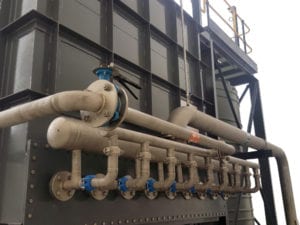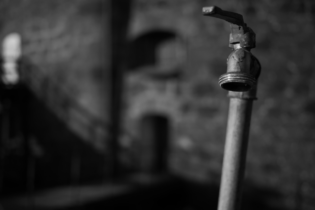Dissolved air flotation is one of the most robust, versatile and widely used unit operations in the treatment of water worldwide. Johan Bieseman, managing director, AquaPlan, speaks to Water&Sanitation Africa about the benefits of this treatment technology.
Why is dissolved air flotation (DAF) an increasingly popular option for clients/end users? JB In the past, DAF systems were often a wish list item. Today, DAF systems have become an intrinsic part of the process of treating water due to their very efficient and cost-effective removal of, among others, suspended solids, chemical oxygen demand and phosphorus in wastewater. This trend has picked up over the past few years, as more pressure is mounting on industries and governments alike to consider the reuse of water in various applications. In which cases can DAF be considered the best available technology? DAF systems have been utilised in the water treatment processes for industrial effluents from steel mills, oil refineries, chemical plants, paper mills, and effluents from food and beverage processes. The implementation of a skid-mounted, modular, cost-effective DAF system as part of the process to produce clear, treated water from industrial effluent from almost any source of water – including wastewaters with high organic content, suspended solids and colour – cannot be over-emphasised. A well-placed, well-designed DAF system offers unprecedented advantages for both up- and downstream processes as part of both the removal of pollutants in the water, as well as the protection of membrane processes downstream of the DAF. Our three most recent installations serve as pre-treatment in the preparation of drinking water from the polluted effluent in food and beverage processes. How does DAF measure up in terms of lead time and cost? AquaPlan has developed a robust, simple, easy-to-operate and versatile range of DAF systems that encompass the dissolving of air, recirculation of white water, as well as the distribution and separation of particles in one simple, skid-mounted system. The material of construction ranges from epoxy-coated carbon steel to 316 stainless steel as the material of choice in food and beverage as well as papermaking applications. All the materials utilised in the manufacturing of a complete DAF system are readily available in the local South African market. Our skid-mounted systems are well suited to be installed into current processes as a pre-treatment to both ultrafiltration and reverse osmosis systems, as well as a post-treatment step for biological processes such as MBR, MBBR and SBR systems. Coupled to well-designed biological systems, the removal and carry-over of suspended and organic matter to post-treatment processes pose a direct threat to the longevity and sustainability of membrane processes. The DAF system is very cost-effective in removing oils, fats, greases, organic compounds, and very fine colloidal suspended solids in one easy process, which effectively removes these unwanted particles from the chain. The process is extremely energy efficient and the float collection mechanism has no moving parts; the waste floats can be lifted off with a simple and automatic hydraulic jump. The equipment is placed on a simple and cost-effective concrete slab, or plinth, by merely lifting the complete system into position. Quick, simple and efficient, the DAF system can be installed and commissioned within two to three days.The low maintenance costs associated with the system, as well as the cost-effective spare parts that are readily available, are welcomed in the industry.
What makes AquaPlan particularly suited to supply DAFs?
AquaPlan has successfully designed, manufactured, installed and commissioned many DAF applications and a wide variety of effluent water and applications over the past 25 years. Our specific in-house experiences in different applications have necessitated optimisation changes to each process, best suited for the application. The current AquaPlan DAF system comprises a fully integrated air saturation and recirculation pump system, flotation basin, lamella-pack integrated settler tubes, scum flotation system, and conical sludge removal underflow, all on to one integrated skid-mounted frame, ready for installation. Our range of systems are simple and quick to install, and cover a very small footprint for large flow rates when compared to conventional clarification systems. Is DAF particularly suited to the South African water sector or is it simply a general-application technology? The biggest driver of recycling water, or reusing any treated effluent, is believed to be the sustainability of water securities, as the availability of both groundwater and surface water resources is rapidly diminishing. The reuse of wastewater will be an absolute necessity when the normal sources run dry or are contaminated. This holds true as a worldwide application and not specifically only in the South African context. South Africa is an arid country with a low average rainfall, where reservoirs and water storage capacities are often extremely low. With the projected population growth over the next 10 years, coupled to the effects of global warming and shifting weather patterns, the use and reuse of water in South Africa as a water source to augment natural sources is a great opportunity to drive sustainability. It is projected that large wastewater works in South Africa that are well established and near city metropoles will adjust their way of treatment through the inclusion of DAF systems. This will provide sources of drinking water to communities who currently simply do not have a sustainable source of drinking water. Is there work to be done in terms of changing people’s attitudes towards effluent and wastewater treated for potable use – even with using DAF as pre-treatment? There is indeed a lot of work to be done. While more pristine natural resources diminish, and the environmental degradation of sustainable habitats is more and more evident as a direct result of industrial activity, the shift to utilise industrial effluent water or wastewater for drinking water will grow exponentially. The technology already exists to produce drinking water from a wide range of non-potable sources such as acid mine drainage, seawater and raw sewage at city outfall points. As responsible citizens, we each have a vested interest in not only minimising waste, but utilising our waste streams in environmentally responsible ways, reducing our carbon footprint and conserving energy. Drinking our own treated waste is slowly gained traction and is indeed our future. Industrial effluent and human wastewater comprise all the unwanted and toxic elements a design engineer in water treatment can be confronted with. These include organic matter, viruses, bacteria, as well as suspended mater, oils and fats that need to be removed. To this effect, a well-positioned DAF is critical in removing most of these constituents. One of the biggest challenges to this process is the protection of the equipment against fouling, blocking and to guard against high energy and maintenance costs within the system.







